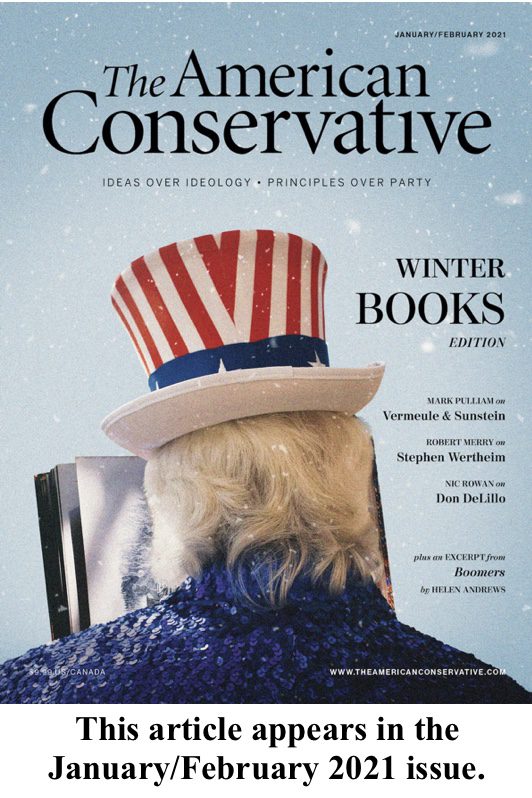Looking Back to Our Realist Past

Isolationism: A History of America’s Efforts to Shield Itself From the World, by Charles Kupchan, (Oxford University Press: October 2020), 464 pages.
Many commentators have remarkably short historical memories. When they think about what should be American grand strategy, they look no further back than 1947 and the early days of the Cold War. The handful of exceptions glance fleetingly to the immediate post-World War I period, recounted as a cautionary tale about the perilous consequences of any decrease in American strategic engagement with the rest of the world.
If an engaged American grand strategy kept the Cold War cold, so the conventional wisdom maintains, why shouldn’t deep engagement remain the default grand strategy for the United States in the post-Cold War era? As Stephen Brooks, John Ikenberry, and William Wohlforth, leading scholarly proponents of deep engagement and liberal internationalism, put it in a co-authored article, “Retrenchment would in essence entail a massive experiment: How would the world work without an engaged, liberal leading power?” Like many other proponents of a more engaged grand strategy, they don’t want to run the experiment.
Former Clinton administration National Security Council staffer, Georgetown University professor, and Council on Foreign Relations think-tanker Charles Kupchan offers a salutary corrective to this strategic inertia. In his new book Isolationism, Kupchan argues that deep engagement is no longer sustainable either in terms of U.S. capabilities or American public support. Moreover, by extending his historical perspective all the way back to the American founding, he provides ample evidence that it is not the only viable alternative out there.
Indeed, for most of our country’s history, the default position for U.S. grand strategy has in fact tended toward the more restrained end of the spectrum, at least outside of North America. “America’s sustained enthusiasm for international engagement,” Kupchan documents, “is the exception, not the rule across the nation’s history.” This restraint mostly served the United States well, as “restraint amid ascent advanced the nation’s interests.” Therefore, Kupchan believes that restraint deserves a second look today, as the United States seeks a strategic map to navigate the tempestuous seas of the post-Cold War world.
Kupchan, like the first generation of neoconservatives, is an internationalist who has been mugged by the reality of recent American foreign policy mistakes. In his view, if we do not close the gaps between America’s interests and capabilities, on the one hand, and our aspirations, on the other, we risk more strategic overreaching such as we did in Iraq and Libya. Some retrenchment and a more restrained grand strategy are the only sustainable basis for continuing American internationalism.
Isolationism has many merits. It comprehensively describes the arc of American diplomatic history from George Washington’s “Farewell Address” to Donald Trump’s redux of “America First.” It is also eminently fair-minded, not only to the liberal internationalists and deep engagers whom Kupchan thinks have set America up for our post-Cold War fall but especially to the alternative grand strategic tradition that Kupchan fears has gotten a bad rap since World War II. “Isolationist,” like “racist,” “sexist,” and “anti-Semite,” is a label that no one wants to be stuck with. That’s why partisans of the status quo brandish it as a rhetorical cudgel against any departure from the activist consensus.
I have two reservations about Kupchan’s well-intentioned effort to rehabilitate isolationism. First, I worry that in using “isolationism” as a synonym for a less engaged foreign policy more generally, Kupchan obscures more than he clarifies. Isolationism, in my view, anchors the far end of the grand strategic continuum as the most disengaged approach to the world. Isolationists want not only less military engagement but also complete political autonomy, economic autarchy, and impermeable borders to restrict immigration. Hardly anyone in the foreign policy debate holds this position any more.
There are, however, other options on the less engaged end of the spectrum of U.S. grand strategy. Restrainers, for example, eschew deep military engagement, believing that technology (especially nuclear weapons) now generally favors defense and that most of our allies can be counted on to defend themselves when push comes to shove. Unlike isolationists, most endorse active diplomacy and free trade and are far less eager to wall off the border to immigrants.
Offshore balancers also want to minimize military commitments abroad but maintain that in some cases the United States needs to be prepared to come back ashore quickly to provide active support to allies facing threats in critical areas of the world. Like restrainers, they generally believe in continuing political and economic engagement around the world.
In the middle of the spectrum, selective engagers assert that the United States needs to maintain a military presence in critical areas of the world, not only to defend them from attack but also to keep them from fighting among themselves. Most otherwise support other forms of international engagement.
Moving toward the activist end, deep engagers not only advocate a permanent U.S. military presence around the world but also see continuing American hegemony as essential to providing such global “public goods” as security, prosperity, and freedom. Liberal internationalists share many common assumptions with deep engagers but hold that American participation in international institutions is as important as U.S. hegemony. Conservative internationalists believe that American primacy combined with the unilateral exercise of American power represents the best way to advance U.S. national interests. Turning the spectrum into a circle, some Jacksonians are willing to use military force abroad, but, in terms of diplomacy and trade, advocate raising the drawbridge.
Read through this framework, Kupchan’s history actually tells a more nuanced story about engagement and U.S. grand strategy. His overarching point, that the period from 1776 through 1898 was characterized by a less engaged approach to U.S. grand strategy, generally holds. But it was not an uninterrupted period of isolationism narrowly defined.
Indeed, the ur-text for this formative period in American foreign policy was George Washington’s “Farewell Address,” in which America’s first president advocated avoiding entangling alliances, but he and his successors were eager to maintain diplomatic and especially economic relations with the rest of the world from the get-go. While U.S. immigration policy was sometimes restrictive, the fact remains that America grew to great-power status as a nation of immigrants, regularly renewed by waves from abroad. To use the same term to describe American foreign policy in the 19th century and the 1930s is inapt.
Second, his argument that it was realism at the end of the 19th century that constituted the first departure from restraint also muddies the conceptual waters. To be sure, the architects of a more activist grand strategy such as navalist Alfred Thayer Mahan and presidents William McKinley and Theodore Roosevelt believed that the United States should seek as much power as possible and use it whenever it could. This makes them machtpolitikers, proponents of power politics, but not necessarily realpolitikers.
The latter understand that preponderant power sparks a reaction against it, and so the most that even great powers like the United States can reliably achieve is a balance of power. There is a long intellectual tradition of restraint based on balance of power, which for example led George Kennan to try to limit America’s waging of the Cold War to a few critical areas and Hans Morgenthau and Kenneth Waltz to object when containment came to include intervening in a civil war in South Vietnam. Today, card-carrying realists such as MIT’s Barry Posen have literally written the book on Restraint and Chicago’s John Mearsheimer and Harvard’s Stephen Walt have become prominent advocates of offshore balancing.
The realist embrace of restraint is, of course, conditional. During the Cold War, most realists endorsed a somewhat more active (but still limited) grand strategy of selective engagement. It was with the collapse of the Soviet Union and the American unipolar moment that the realist center of gravity shifted to a point somewhere between offshore balancing and full-out restraint.
 Perhaps the most important reason to separate isolationism from other less militarily engaged strategic postures is to ensure that the passing of the Trump administration’s “America First” policy does not sound the death knell for the broader restraint agenda. There are grounds for cautious optimism. Even before 2016, restraint had started to make some in-roads among Democrats. Its logic convinced President Obama to avoid what was likely to be a costly and unproductive intervention into Syria. Then-vice president Joe Biden also reportedly opposed the fruitless surge of additional forces into Afghanistan to prolong that endless war. As Kupchan recognizes, the institutional foundation for a bipartisan restraint coalition has already been laid by George Soros and Charles Koch with their joint venture, the Quincy Institute for Responsible Statecraft. In that same spirit, we should welcome Charlie Kupchan to Team Restraint with open arms.
Perhaps the most important reason to separate isolationism from other less militarily engaged strategic postures is to ensure that the passing of the Trump administration’s “America First” policy does not sound the death knell for the broader restraint agenda. There are grounds for cautious optimism. Even before 2016, restraint had started to make some in-roads among Democrats. Its logic convinced President Obama to avoid what was likely to be a costly and unproductive intervention into Syria. Then-vice president Joe Biden also reportedly opposed the fruitless surge of additional forces into Afghanistan to prolong that endless war. As Kupchan recognizes, the institutional foundation for a bipartisan restraint coalition has already been laid by George Soros and Charles Koch with their joint venture, the Quincy Institute for Responsible Statecraft. In that same spirit, we should welcome Charlie Kupchan to Team Restraint with open arms.
Michael C. Desch is Packey J. Dee Professor of International Relations and Brian and Jeannelle Brady Family Director of the Notre Dame International Security Center.